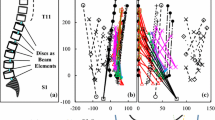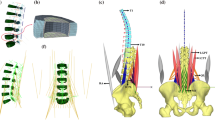Abstract
To overcome certain back pain problems or enhance body performance in sports applications, a biomechanical study of the dynamic response of the human trunk is important to understand and predict its response in different loading conditions involving time-dependent excitations. In this work, it is proposed to use a simple experimental protocol and a 3D finite element dynamic model to extract effective stiffness, inertial and dam** characteristics of the human trunk. A setup is designed to collect data from the motion of the trunk of a healthy subject attached around its pelvis, in an upright position with a small time-dependent applied force to its thoracic region via a securely designed small-amplitude crank–rod mechanism. The applied force and the subsequent displacements at the thoracic vertebrae T8 level are measured using a load cell and a laser displacement sensor, respectively. The experimental results are used to update a 3D multi-body musculoskeletal model. The model of the trunk is subdivided into 335 elements with independent geometrical and physical properties. A Newmark method is used to solve the derived equations in time, extract the dynamic properties of the trunk, and compare the results with those obtained experimentally. It is also shown that the simulated transient displacement is similar to the one obtained experimentally for relatively small time intervals. The collected experimental data are used to calculate the effective mass, stiffness, and dam** factor and observe the effect of the applied excitation conditions on the dynamic response. These results are compared with those obtained numerically with the developed musculoskeletal model. Good agreement was observed for the variation of the effective dynamic properties of the trunk between the experimental and numerical results.







Similar content being viewed by others
References
Abouhossein, A., Weisse, B., Ferguson, S.J.: A multibody modelling approach to determine load sharing between passive elements of the lumbar spine. Comp. Meth. Biomech. Biomed. Eng. 14(06), 527–537 (2011)
Ackermann, M., Schiehlen, W.: Dynamic analysis of human gait disorder and metabolical cost estimation. Arch. Appl. Mech. 75(10), 569–594 (2006)
Bazrgari, B., Shirazi-Adl, A., Arjmand, N.: Analysis of squat and stoop dynamic liftings: muscle forces and internal spinal loads. Eur. Spine J. 16(5), 687–699 (2007)
Bazrgari, B., Shirazi-Adl, A., Kasra, M.: Computation of trunk muscle forces, spinal loads and stability in whole-body vibration. J. Sound Vibrat. 318(4–5), 1334–1347 (2008)
Bergmark, A.: Stability of the lumbar spine: a study in mechanical engineering. Acta Orthop. Scand. 60(sup230), 1–54 (1989)
Callaghan, J.P., McGill, S.M.: Low back joint loading and kinematics during standing and unsupported sitting. Ergonomics 44(3), 280–294 (2001)
Cameron, J.R., Skofronick, J.G., Grant, R.M., Morin, R.L.: Physics of the body. Wiley Online (2000)
Cholewicki, J., McGill, S.M., Norman, R.W.: Comparison of muscle forces and joint load from an optimization and EMG assisted lumbar spine model: towards development of a hybrid approach. J. Biomech. 28(3), 321–331 (1995)
Christophy, M., Senan, N.A.F., Lotz, J.C., O’Reilly, O.M.: A musculoskeletal model for the lumbar spine. Biomech. Model. Mechanobiol. 11(1), 19–34 (2012)
Delerba F (2001) Modélisation géométrique et mécanique tridimensionnelle du rachis thoracique et lombaire en configuration de choc automobile. Phd thesis, Arts et Métiers ParisTech, https://pastel.archives-ouvertes.fr/tel-00005772
Dreischarf, M., Zander, T., Shirazi-Adl, A., Puttlitz, C., Adam, C., Chen, C., Goel, V., Kiapour, A., Kim, Y., Labus, K., et al.: Comparison of eight published static finite element models of the intact lumbar spine: predictive power of models improves when combined together. J. Biomech. 47(8), 1757–1766 (2014)
Dreischarf, M., Shirazi-Adl, A., Arjmand, N., Rohlmann, A., Schmidt, H.: Estimation of loads on human lumbar spine: a review of in vivo and computational model studies. J. Biomech. 49(6), 833–845 (2016)
Erdemir, A., McLean, S., Herzog, W., van den Bogert, A.J.: Model-based estimation of muscle forces exerted during movements. Clin. Biomech. 22(2), 131–154 (2007)
Fice, J.B., Cronin, D.S., Panzer, M.B.: Cervical spine model to predict capsular ligament response in rear impact. Ann. Biomed. Eng. 39(8), 2152–2162 (2011)
Gareis, H., Moshe, S., Baratta, R., Best, R., D’Ambrosia, R.: The isometric length-force models of nine different skeletal muscles. J. Biomech. 25(8), 903–916 (1992)
Glowinski, S., Krzyzynski, T., Pecolt, S., Maciejewski, I.: Design of motion trajectory of an arm exoskeleton. Arch. Appl. Mech. 85(1), 75–87 (2015)
Granata, K.P., Marras, W.: An EMG-assisted model of trunk loading during free-dynamic lifting. J. Biomech. 28(11), 1309–1317 (1995)
Han, K.S., Zander, T., Taylor, W.R., Rohlmann, A.: An enhanced and validated generic thoraco-lumbar spine model for prediction of muscle forces. Med. Eng. & Phys. 34(6), 709–716 (2012)
Harrington, T.A., Thomas, E.L., Frost, G., Modi, N., Bell, J.D.: Distribution of adipose tissue in the newborn. Pediatr. Res. 55(3), 437–441 (2004)
Herman, I.P.: Physics of the human body. Springer, Berlin (2016)
Honegger, J.D., Actis, J.A., Gates, D.H., Silverman, A.K., Munson, A.H., Petrella, A.J.: Development of a multiscale model of the human lumbar spine for investigation of tissue loads in people with and without a transtibial amputation during sit-to-stand. Biomech. Model. Mechanobiol. 20(1), 339–358 (2021)
Humar, J.: Dynamics of structures. CRC Press, Cambridge (2012)
Inman DJ (2006) Vibration with control. Wiley Online Library
Jalalian, A., Gibson, I., Tay, E.H.: Computational biomechanical modeling of scoliotic spine: challenges and opportunities. Spine Deformity 1(6), 401–411 (2013)
Keller, T.S., Colloca, C.J.: A rigid body model of the dynamic posteroanterior motion response of the human lumbar spine. J.Manipul. Pysiol. Therapeut. 25(8), 485–496 (2002)
Lafage, V., Dubousset, J., Lavaste, F., Skalli, W.: 3D finite element simulation of cotrel-dubousset correction. Comp. Aid. Surg. 9(1–2), 17–25 (2004)
Marras, W.S., Granata, K.P.: The development of an emg-assisted model to assess spine loading during whole-body free-dynamic lifting. J. Electromyogr. Kinesiol. 7(4), 259–268 (1997)
Mehrez, S., Smaoui, H.: Directional dependence of experimental trunk stiffness: Role of muscle-stiffness variation of nonneural origin. Appl. Bion. Biomech 2020, 8837147 (2020). https://doi.org/10.1155/2020/8837147
Mehrez, S., Smaoui, H., Ben Salah, F.Z.: A biomechanical model to simulate the effect of a high vertical loading on trunk flexural stiffness. Comp. Meth. Biomech. Biomed. Eng. 17(9), 1032–1041 (2014)
Meirovitch, L.: Fundamentals of vibrations. Waveland Press, Illinois (2010)
Méndez, J.: Density and composition of mammalian muscle. Metabolism 9, 184–188 (1960)
Moalla F, Mehrez S, Najar F (2018) Dynamic identification of human trunk behavior as a diagnosis tool for pathologic problems. In: 2018 IEEE 4th Middle east conference on biomedical engineering (MECBME), IEEE, pp 51–55
Moorhouse, K.M., Granata, K.P.: Trunk stiffness and dynamics during active extension exertions. J. Biomech. 38(10), 2000–2007 (2005)
Phillips, S., Mercer, S., Bogduk, N.: Anatomy and biomechanics of quadratus lumborum. Proceed. Institut. Mech. Eng., Part H: J. Eng. Med. 222(2), 151–159 (2008)
Pierce, D.M.: Multi-phase, large-strain constitutive models of cartilage for finite element analyses in 3-d. Arch. Appl. Mech. (2021). https://doi.org/10.1007/s00419-021-01959-5
Tunisian Ministry of Public Health TN (2021) Institut pasteur de tunis. http://www.pasteur.tn, accessed: 2021-12-17
Rupp, T., Ehlers, W., Karajan, N., Günther, M., Schmitt, S.: A forward dynamics simulation of human lumbar spine flexion predicting the load sharing of intervertebral discs, ligaments, and muscles. Biomech. Model. Mechanobiol. 14(5), 1081–1105 (2015)
Schmidt, H., Bashkuev, M., Dreischarf, M., Rohlmann, A., Duda, G., Wilke, H.J., Shirazi-Adl, A.: Computational biomechanics of a lumbar motion segment in pure and combined shear loads. J. Biomech. 46(14), 2513–2521 (2013)
Stokes, I.A., Gardner-Morse, M.: Quantitative anatomy of the lumbar musculature. J. Biomech. 32(3), 311–316 (1999)
World Health Organization WHO (2021) Priority diseases and reasons for inclusion. https://www.who.int/medicines/areas/priority_medicines/Ch6_24LBP.pdf, accessed: 2021-12-06
Zajac, F.E.: Muscle and tendon: properties, models, scaling, and application to biomechanics and motor control. Crit. Rev. Biomed. Eng. 17(4), 359–411 (1989)
Author information
Authors and Affiliations
Corresponding author
Ethics declarations
Conflict of interest
The authors declare that they have no conflict of interest.
Additional information
Publisher's Note
Springer Nature remains neutral with regard to jurisdictional claims in published maps and institutional affiliations.
Rights and permissions
Springer Nature or its licensor (e.g. a society or other partner) holds exclusive rights to this article under a publishing agreement with the author(s) or other rightsholder(s); author self-archiving of the accepted manuscript version of this article is solely governed by the terms of such publishing agreement and applicable law.
About this article
Cite this article
Moalla, F., Mehrez, S. & Najar, F. Multi-body musculoskeletal dynamic model of the human trunk based on an experimental approach. Arch Appl Mech 93, 1201–1215 (2023). https://doi.org/10.1007/s00419-022-02323-x
Received:
Accepted:
Published:
Issue Date:
DOI: https://doi.org/10.1007/s00419-022-02323-x




